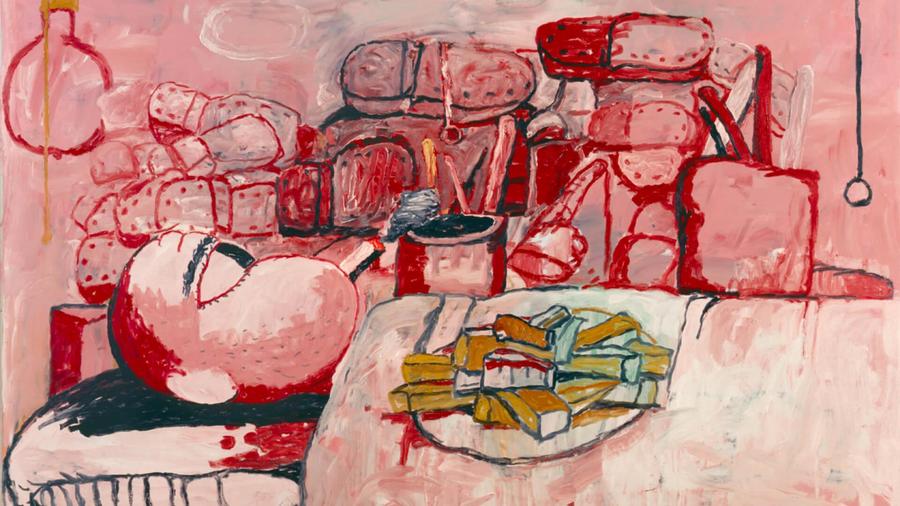Tate Modern, London, February 4 – May 31, 2021
National Gallery of Art, Washington, July 3 – October 3, 2021
Museum of Fine Arts, Boston, November 7, 2021 – February 6, 2022
The Museum of Fine Arts, Houston, March 6 – May 30, 2022

Philip Guston: Now is a touring exhibition that caused controversy when the dates were initally rescheduled to four years out. One of America’s greatest modern painters, Philip Guston (1913–1980) defies easy categorization. His winding 50-year career, in which sensitive abstractions gave way to large, cartoonlike canvases populated by lumpy, sometimes tortured figures and mysterious personal symbols, has excited both admiration and controversy.
This major exhibition—organized by the MFA, the National Gallery of Art, Washington, the Museum of Fine Arts, Houston, and Tate Modern, London—is the first retrospective of Guston’s work in nearly 20 years. The selection of approximately 90 paintings and 30 drawings from public and private collections features well-known works as well as others that have rarely been seen. Highlights include paintings from the 1930s that have never been on public view; the largest reunion of paintings from Guston’s groundbreaking Marlborough Gallery show in 1970; a dazzling array of small panel paintings made from 1968 to 1972 as he developed his new vocabulary of hooded heads, books, bricks and shoes; and a powerful selection of large, often apocalyptic paintings of the later 1970s that form the artist’s last major artistic statement.
One of America's greatest modern painters, Philip Guston (1913–1980) uniquely bridged the personal and the political, the abstract and the figurative, and the humorous and the tragic in paintings of lively touch and memorable impact. A major retrospective of the artist, Philip Guston Now, the first in more than 15 years, will present a balanced view of the artist's 50-year career.
A selection of approximately 125 paintings and 70 drawings from some 40 public and private collections will feature well-known works as well as others that have rarely been seen. Highlights include paintings from the 1930s that have never been on public view; the largest reunion of paintings from his groundbreaking Marlborough Gallery show in 1970; a thorough representation of satirical drawings of Richard Nixon and his associates; a dazzling array of small panel paintings made in 1968–1972 as Guston was developing his new vocabulary of hoods, books, bricks, and shoes; and a powerful selection of large, often apocalyptic paintings of the later 1970s that form the artist's last major artistic statement. A fully illustrated monograph will include essays by the exhibition's co-curators and a richly illustrated chronology of his life and work, along with reflections by contemporary artists on their engagement with Guston and the impact of his work and legacy.
"Philip Guston's paintings have inspired generations of artists while also defying easy definition," said Kaywin Feldman, director, National Gallery of Art, Washington. "This exhibition will provide an in-depth look at the career that led to his iconic late paintings and will surely secure Guston's place in the pantheon of modern art, while reassessing his impact on the art of the present."
A sweeping retrospective of Philip Guston’s influential work, from Depression-era muralist to abstract expressionist to tragicomic contemporary master
A Wall Street Journal 2020 holiday gift guide pick
Philip Guston―perhaps more than any other figure in recent memory―has given contemporary artists permission to break the rules and paint what, and how, they want. His winding career, embrace of “high” and “low” sources, and constant aesthetic reinvention defy easy categorization, and his 1968 figurative turn is by now one of modern art’s most legendary conversion narratives. “I was feeling split, schizophrenic. The war, what was happening in America, the brutality of the world. What kind of man am I, sitting at home, reading magazines, going into a frustrated fury about everything―and then going into my studio to adjust a red to a blue?”
And so Guston’s sensitive abstractions gave way to large, cartoonlike canvases populated by lumpy, sometimes tortured figures and mysterious personal symbols in a palette of juicy pinks, acid greens, and cool blues. That Guston continued mining this vein for the rest of his life―despite initial bewilderment from his peers―reinforced his reputation as an artist’s artist and a model of integrity; since his death 50 years ago, he has become hugely influential as contemporary art has followed Guston into its own antic twists and turns.
Published to accompany the first retrospective museum exhibition of Guston’s career in over 15 years, Philip Guston Nowincludes a lead essay by Harry Cooper surveying Guston's life and work, and a definitive chronology reflecting many new discoveries. It also highlights the voices of artists of our day who have been inspired by the full range of his work: Tacita Dean, Peter Fischli, Trenton Doyle Hancock, William Kentridge, Glenn Ligon, David Reed, Dana Schutz, Amy Sillman, Art Spiegelman and Rirkrit Tiravanija. Thematic essays by co-curators Mark Godfrey, Alison de Lima Greene and Kate Nesin trace the influences, interests and evolution of this singular force in modern and contemporary art―including several perspectives on the 1960s and ’70s, when Guston gradually abandoned abstraction, returning to the figure and to current history but with a personal voice, by turns comic and apocalyptic, that resonates today more than ever.


